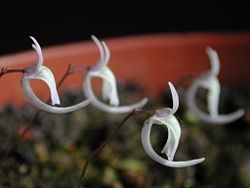
Spur (biology)
Encyclopedia

In certain plants, part of a sepal
Sepal
A sepal is a part of the flower of angiosperms . Collectively the sepals form the calyx, which is the outermost whorl of parts that form a flower. Usually green, sepals have the typical function of protecting the petals when the flower is in bud...
or petal
Petal
Petals are modified leaves that surround the reproductive parts of flowers. They often are brightly colored or unusually shaped to attract pollinators. Together, all of the petals of a flower are called a corolla. Petals are usually accompanied by another set of special leaves called sepals lying...
develops into an elongated hollow spike extending behind the flower
Flower
A flower, sometimes known as a bloom or blossom, is the reproductive structure found in flowering plants . The biological function of a flower is to effect reproduction, usually by providing a mechanism for the union of sperm with eggs...
, containing nectar which is sucked by long-tongued animals (insects, birds or bats). Plants with such structures include Delphinium
Delphinium
Delphinium is a genus of about 300 species of perennial flowering plants in the buttercup family Ranunculaceae, native throughout the Northern Hemisphere and also on the high mountains of tropical Africa. The common name, larkspur, is shared with the closely related genus Consolida...
, Aquilegia
Aquilegia
Aquilegia is a genus of about 60-70 species of perennial plants that are found in meadows, woodlands, and at higher altitudes throughout the Northern Hemisphere, known for the spurred petals of their flowers.-Etymology:The genus name Aquilegia is derived from the Latin word for eagle , because...
, Piperia
Piperia
Piperia is a genus of the orchid family Orchidaceae. These plants are known as rein orchids. They are native to western North America, especially California and the Pacific Northwest...
, and some orchids, such as Gymnadenia
Gymnadenia
Gymnadenia is a genus in the orchid family containing 22 terrestrial species.They can be found in damp meadows, fens and marshes, and on chalk or limestone, often in alpine regions of Europe and Asia up to the Himalayas. The Fragrant Orchid has been introduced into the USA.These hardy terrestrial...
. Spurs may be useful in species identification – for example Yadon's piperia cannot be easily distinguished from other Piperia save for the unusually short length of its spur.
In tropical pitcher plant
Pitcher plant
Pitcher plants are carnivorous plants whose prey-trapping mechanism features a deep cavity filled with liquid known as a pitfall trap. It has been widely assumed that the various sorts of pitfall trap evolved from rolled leaves, with selection pressure favouring more deeply cupped leaves over...
s of the genus Nepenthes
Nepenthes
The Nepenthes , popularly known as tropical pitcher plants or monkey cups, are a genus of carnivorous plants in the monotypic family Nepenthaceae. The genus comprises roughly 130 species, numerous natural and many cultivated hybrids...
, the spur is a small appendage at the base of the pitcher lid.
See also
- SepalSepalA sepal is a part of the flower of angiosperms . Collectively the sepals form the calyx, which is the outermost whorl of parts that form a flower. Usually green, sepals have the typical function of protecting the petals when the flower is in bud...
- PetalPetalPetals are modified leaves that surround the reproductive parts of flowers. They often are brightly colored or unusually shaped to attract pollinators. Together, all of the petals of a flower are called a corolla. Petals are usually accompanied by another set of special leaves called sepals lying...
- TepalTepalTepals are elements of the perianth, or outer part of a flower, which include the petals or sepals. The term tepal is more often applied specifically when all segments of the perianth are of similar shape and color, or undifferentiated, which is called perigone...
- Calyx
- Corolla

